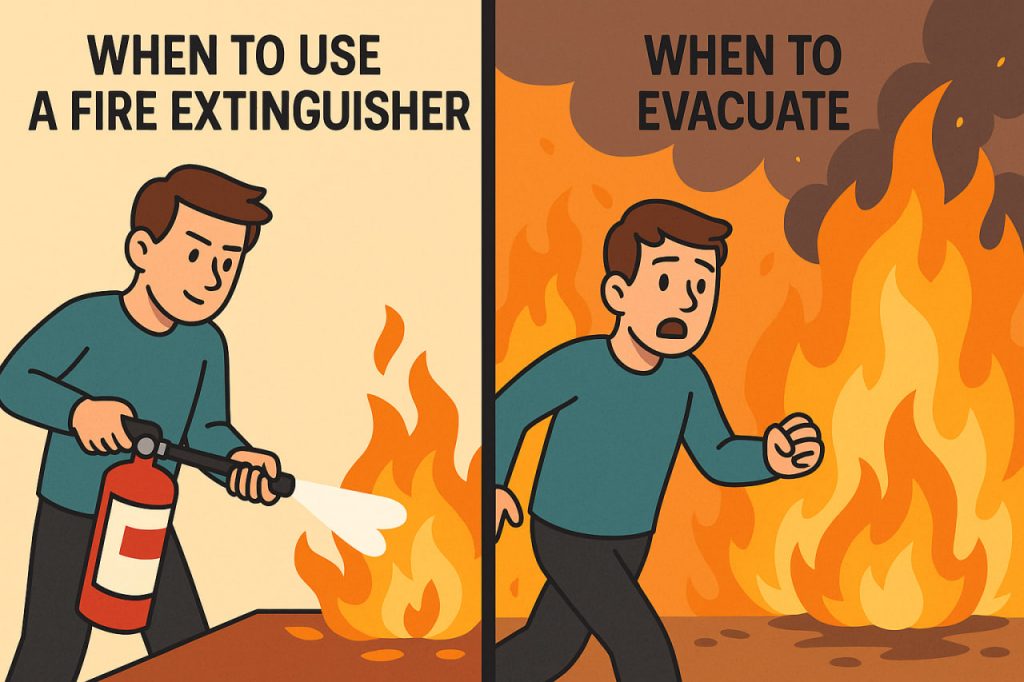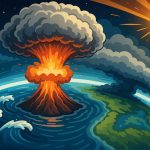Fire is one of humanity’s oldest allies — and most dangerous enemies. A small flame can provide warmth and light, but left unchecked, it can destroy homes, forests, and lives within minutes. Knowing when to try extinguishing a fire and when to evacuate immediately is critical for survival. Understanding how to act calmly and effectively can save not only your property but also your life.
When You Should Try to Extinguish a Fire
Not all fires are the same. Some can be managed safely with basic tools, while others require professional firefighters. You should attempt to extinguish a fire only if all the following conditions are met:
- The fire is small and contained. For example, a small kitchen flame, burning paper, or a candle flare-up.
- You have a clear escape route. Never fight a fire if your exit could be blocked by smoke or flames.
- You have the right equipment. Use a fire extinguisher, blanket, or water — but only if it’s suitable for the fire type.
- You’re trained or confident. You must act quickly but not recklessly. Panic or hesitation can make the fire spread faster.
If the fire doesn’t begin to die down within 10–15 seconds of your attempt, stop immediately and evacuate. Call emergency services and let professionals handle it.
When You Should NOT Try to Extinguish a Fire
There are situations when trying to fight a fire is far more dangerous than fleeing. Do not attempt to extinguish a fire if:
- The fire is spreading rapidly or involves an entire room.
- Thick smoke makes it difficult to breathe or see.
- Flammable or toxic substances (like fuel, paint, or gas) are burning.
- The fire involves electricity or unknown chemicals.
- You’re alone and don’t have immediate access to help.
Smoke inhalation can cause unconsciousness in less than two minutes. Many fire-related deaths occur not from burns, but from suffocation and toxic gas inhalation.
How to Extinguish Small Fires Safely
Each type of fire requires a specific method of extinguishing:
1. Solid Materials (Paper, Wood, Fabric)
- Use water or a fire extinguisher labeled Class A.
- If it’s a small surface flame, cover it with a wet cloth to remove oxygen.
2. Flammable Liquids (Oil, Gasoline, Alcohol)
- Never use water — it spreads the burning liquid.
- Use a foam or CO₂ extinguisher (Class B).
- For a small oil fire in the kitchen, cover the pan with a metal lid to smother the flames.
3. Electrical Fires
- Turn off power immediately if possible.
- Use a CO₂ or dry powder extinguisher (Class C).
- Never use water or wet cloths — they conduct electricity.
4. Gas or Chemical Fires
- Evacuate immediately and call emergency services.
- Shut off the gas valve if safe to do so.
- These fires are highly toxic and unpredictable — don’t try to fight them.
The Importance of Fire Extinguishers
Every home, vehicle, and workplace should have at least one fire extinguisher. Learn how to use it with the PASS rule:
- P – Pull the pin.
- A – Aim at the base of the fire.
- S – Squeeze the handle.
- S – Sweep side to side until the fire goes out.
Check extinguisher pressure regularly and replace expired units.
If You Can’t Put Out the Fire
If the fire grows uncontrollably:
- Evacuate immediately — don’t try to save possessions.
- Close doors behind you to slow the spread of smoke.
- Crawl under smoke, where the air is cleaner.
- Call emergency services from a safe location.
- Never go back inside until authorities declare it safe.
Preventing Fires in the First Place
- Avoid leaving cooking unattended.
- Check electrical wiring regularly.
- Keep flammable materials away from heat sources.
- Install and maintain smoke detectors in every room.
- Teach children about fire safety early.
Interesting Facts
- A small flame can double in size every 30 seconds.
- More than 50% of home fires start in kitchens.
- Smoke alarms reduce fire-related death risk by over 50%.
- You can lose consciousness after two breaths of toxic smoke.
- Fire needs three things to exist — heat, fuel, and oxygen. Removing one stops the fire.
Glossary
- Fire extinguisher — a portable device used to control small fires.
- Combustion — a chemical reaction producing heat and light (fire).
- Flammable — capable of catching fire easily.
- Smoke inhalation — breathing in toxic gases from a fire, often deadly.
- Fire triangle — the three elements (heat, fuel, oxygen) required for fire to burn.


